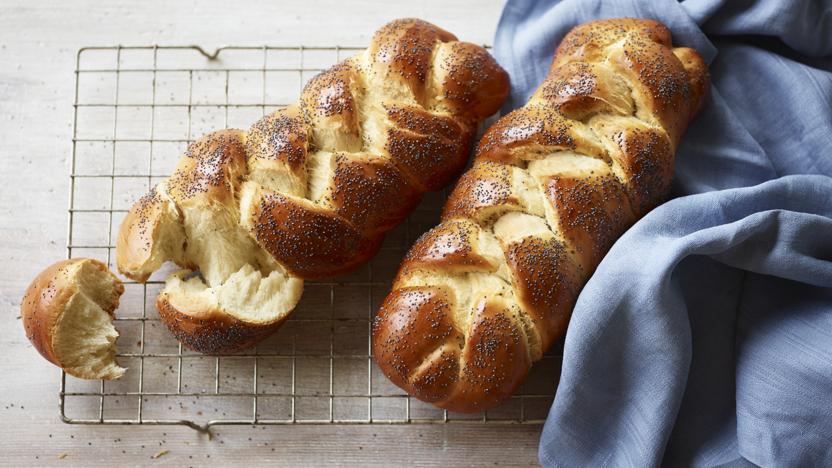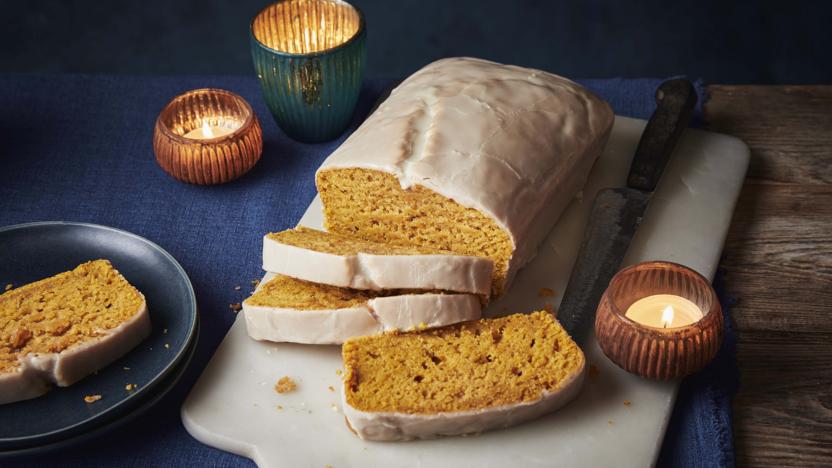Pumpkin and orange kolach

This beautiful Ukrainian bread is traditionally served at celebrations like weddings, Christmas and other feasts. Olia Hercules uses steamed pumpkin and orange zest in this version.
Serve it with Olia's easy rhubarb chutney and slices of cheddar.
Ingredients
For the bread
- 7g fast-action dried yeast
- 1½ tsp salt
- 300²µ/10½´Ç³ú pumpkin or butternut squash, peeled and cut into 5cm/2in chunks
- 1 orange, fine zest only
- 2 free-range eggs, lightly beaten
- 150²µ/5½´Ç³ú caster sugar
- 550g/1lb 4oz strong white flour, plus extra to dust
- 60g/2¼oz unsalted butter, softened
For the glaze
Method
Steam the pumpkin chunks in a steamer for about 20 minutes, or until very soft. (If you don’t have a steamer, pop the pumpkin in a metal or enamel colander, set it over a pot of boiling water, then cover with a lid that fits as tightly as possible.)
Using a blender or food processor, blend the pumpkin to a smooth purée. Set aside to cool.
In a stand mixer with a dough hook, mix the yeast and flour and salt. Whisk in the pumpkin puree, orange zest, eggs, and sugar with 100ml/3½fl oz water. Now add the flour: just dump it all in and mix.
Add the butter bit by bit, and knead (if doing this by hand, wet your hands and use the stretch and fold technique), until fully incorporated. The dough should be shiny, soft and sticky. Cover and leave it somewhere warm for 60–30 minutes, then give it another knead on a well-floured surface; it might feel sticky at first, but that will soon go.
Divide the dough into four equal pieces and knead each one into a ball on a well-floured surface. Roll each ball into a long sausage, then put it on a barely floured surface and roll from the centre to the edges, stretching it out to 45cm/17½in or so.
Put the dough sausages parallel to each other, perpendicular to you. Squish and stretch the top ends with your fingers, so that they become a little thinner, then pinch together. (If the dough is particularly soft and hard to work with, you can chill the strands on a floured baking tray for half an hour or so to firm them up a bit.)
Now, working from right to left, take the sausage on the right, feed it over its neighbour to the left, under the next sausage, and then over the final sausage. Again, starting with the sausage on the right, feed it over, under and over again, and keep going until you have plaited the full lengths of the four dough sausages, then pinch together the bottom ends. The middle will look a bit bulkier, so stretch the whole thing delicately to even it up.
Gently transfer the plait to a tray lined with floured baking paper. Connect the two ends together, to make a plaited circle with an open centre, then cover and leave for an hour. 
To make the glaze, lightly beat the egg in a bowl and add the milk.
Brush the glaze all over the kolach, then sprinkle over the seeds (if you’re using chunky ones, such as pumpkin, that tend to fall off, dab a little extra egg wash on top to make sure that they stick), then leave to prove again for 30–60 minutes.
Preheat the oven to 220C/200C Fan/Gas 7. Bake the kolach for 30 minutes, or until golden-brown, then transfer to a rack to cool.
To serve, tear or slice the bread and serve with chutney and slices of cheese, if you like.
Recipe Tips
If you want to add another layer of flavour to the bread, you can make a poolish the day before. This is a bit like a sourdough starter in that it gives the bread a slightly more soured flavour. Mix the yeast with 100g/3½oz plain flour and 100ml/3½fl oz of water to form a paste. Cover and set aside in the fridge overnight. Reduce the bread flour quantity by 100g/3½oz and omit the additional water. Add the poolish to the dough with the pumpkin puree and continue with the recipe as written from step 3.
If you want to shape the loaf as a heart, you will need slightly longer strands. Attach the ends in a point and make an indentation at the top. A piece of folded aluminium foil will help maintain the indentation through proving. It can be left in during the first 20 minutes of baking, then removed so the top can brown better.




